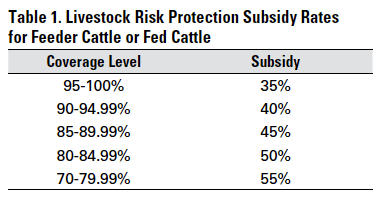Bagley Risk Management : Safeguarding Your Organization Future
Bagley Risk Management : Safeguarding Your Organization Future
Blog Article
Recognizing Livestock Risk Protection (LRP) Insurance Policy: A Comprehensive Overview
Browsing the world of livestock risk protection (LRP) insurance coverage can be a complicated venture for numerous in the agricultural industry. From exactly how LRP insurance policy operates to the different insurance coverage alternatives readily available, there is much to reveal in this comprehensive guide that can possibly form the method animals producers approach risk management in their businesses.

Exactly How LRP Insurance Functions
Occasionally, recognizing the technicians of Livestock Danger Security (LRP) insurance policy can be complicated, however breaking down exactly how it functions can give clearness for herdsmans and farmers. LRP insurance policy is a danger management tool created to shield livestock manufacturers versus unforeseen cost decreases. It's vital to note that LRP insurance policy is not a revenue warranty; rather, it concentrates exclusively on cost threat protection.
Eligibility and Insurance Coverage Options

When it pertains to insurance coverage options, LRP insurance coverage uses producers the flexibility to select the insurance coverage degree, coverage period, and recommendations that best fit their risk monitoring demands. Coverage degrees typically range from 70% to 100% of the anticipated finishing worth of the insured animals. Producers can also choose insurance coverage periods that straighten with their production cycle, whether they are insuring feeder cattle, fed livestock, swine, or lamb. Recommendations such as price risk protection can further customize protection to shield versus adverse market fluctuations. By comprehending the qualification standards and coverage alternatives available, animals manufacturers can make educated choices to take care of threat successfully.
Pros and Disadvantages of LRP Insurance Coverage
When examining Livestock Threat Defense (LRP) insurance, it is vital for animals manufacturers to weigh the disadvantages and benefits fundamental in this risk monitoring device.

Among the primary benefits of LRP insurance coverage is its capacity to supply protection against a decline in livestock costs. This can help protect producers from economic losses resulting from market fluctuations. Furthermore, LRP insurance provides a level of flexibility, permitting manufacturers to customize protection levels and plan periods to suit their specific demands. By locking in an ensured price for their livestock, producers can much better take care of threat and prepare for the future.
Nonetheless, there are also some drawbacks to consider. One constraint of LRP insurance policy is that it does not shield versus all sorts of risks, such as disease episodes or all-natural disasters. Premiums can occasionally be expensive, especially for producers with huge livestock herds. It is important for producers to carefully assess their specific threat direct exposure and monetary situation to identify if LRP insurance is the appropriate threat monitoring tool for their operation.
Comprehending LRP Insurance Policy Premiums

Tips for Making Best Use Of LRP Benefits
Optimizing the advantages of Animals Risk Protection (LRP) insurance coverage calls for strategic planning and proactive danger administration - Bagley Risk Management. To make the many of your LRP coverage, take into consideration the adhering to pointers:
Routinely Analyze Market Problems: Stay informed regarding market patterns and cost fluctuations in the livestock industry. By keeping track of these elements, you can make informed decisions regarding when to buy LRP protection to safeguard versus possible losses.
Set Realistic Coverage Levels: When selecting insurance coverage degrees, consider your production prices, market price of animals, and prospective dangers - Bagley Risk Management. Setting reasonable protection levels makes sure that you are my response properly protected without paying too much for unneeded insurance policy
Diversify Your Coverage: As opposed to counting exclusively on LRP insurance coverage, take into consideration diversifying your threat monitoring methods. Combining LRP with various other risk administration devices such as futures agreements or choices can give comprehensive coverage versus market unpredictabilities.
Review and Readjust Protection Consistently: As market problems change, regularly review your LRP coverage to ensure it aligns with your present risk direct exposure. Changing insurance coverage levels and timing of purchases can assist optimize your danger defense strategy. By adhering like this to these ideas, you can optimize the benefits of LRP insurance policy and secure your animals operation versus unforeseen dangers.
Verdict
In verdict, livestock threat protection (LRP) insurance coverage is an important device for farmers to manage the financial threats associated with their livestock operations. By comprehending just how LRP functions, eligibility and protection alternatives, as well as the benefits and drawbacks of this insurance policy, farmers can make informed decisions to shield their incomes. By very carefully thinking about LRP premiums and applying methods to optimize advantages, farmers can minimize prospective losses and guarantee the sustainability of their procedures.
Animals producers interested in getting Animals Threat Defense (LRP) insurance policy can check out a range of eligibility standards and protection choices tailored to their particular livestock procedures.When it comes to coverage alternatives, LRP insurance provides manufacturers the versatility to choose the insurance coverage level, protection duration, and endorsements that finest suit their risk monitoring requirements.To comprehend the details of Animals Danger Security (LRP) insurance coverage fully, understanding the elements influencing LRP insurance policy costs is check my source critical. LRP insurance policy premiums are determined by different elements, including the insurance coverage level selected, the expected rate of livestock at the end of the insurance coverage duration, the type of livestock being guaranteed, and the length of the coverage period.Evaluation and Adjust Insurance Coverage Routinely: As market problems alter, periodically assess your LRP protection to ensure it straightens with your present danger direct exposure.
Report this page